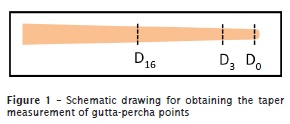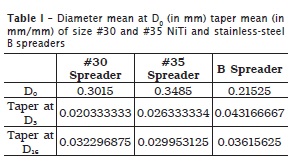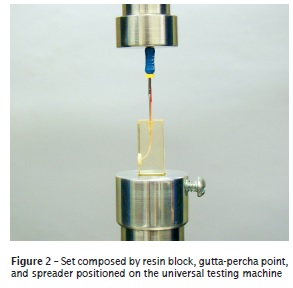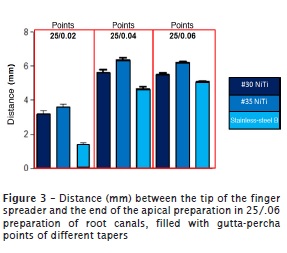Serviços Personalizados
Artigo
Links relacionados
Compartilhar
RSBO (Online)
versão On-line ISSN 1984-5685
RSBO (Online) vol.11 no.4 Joinville Out./Dez. 2014
ORIGINAL RESEARCH ARTICLE
Influence of the gutta-percha taper and finger spreader on lateral condensation effectiveness
Adinael Trindade-Junior I; Juliane Maria Guerreiro-Tanomaru I; Raqueli Viapiana I; José Mauricio Santos Nunes Reis II; Mario Tanomaru-Filho I
I Department of Restorative Dentistry, School of Dentistry, Sao Paulo State University – Araraquara – SP – Brazil
II Department of Dental Materials and Prosthesis, School of Dentistry, Sao Paulo State University – Araraquara – SP – Brazil
ABSTRACT
Introduction: Lateral condensation effectiveness may be influenced by the gutta-percha and finger spreader taper used during root canal obturation. Objective: To evaluate the penetration ability of finger spreader into simulated root canals prepared using MTwo rotary system and filled with different gutta-percha and finger spreader tapers. Material and methods: Resin blocks with curved root canals had the apical diameter enlarged up to #25.06 and distributed into groups (n = 6) according to the gutta-percha taper (#25.02, #25.04, and #25.06) and the finger spreader (#30 and #35 NiTi, and stainless steel B) used to perform cold lateral condensation. After applying a load of 1.5 Kg over the finger spreaders' head, the distance between the finger spread tip and the apical limit of the root canal preparation were obtained. The data were submitted to Anova and Tukey-Krammer's test, with 5% of significance. Results: The gutta-percha cones with 0.02 taper enabled higher finger spreader penetration when compared to 0.04 and 0.06 tapers (p < 0.05), which were similar between each other (p > 0.05), regardless of the type and diameter of the finger spreader used. When different finger spreaders were compared among themselves, stainless steel B showed higher penetration ability (p < 0.05). Conclusion: It was concluded that the stainless-steel finger spreaders showed superior penetration ability and gutta-percha with lower tapers enabled a more effective lateral condensation at the apical third.
Keywords: Endodontics; root canal obturation; gutta-percha.
Introduction
The endodontic therapy aiming at the cleaning, disinfection, shaping and tridimensional obturation of the root canal system. All endodontic treatment stages are interdependently and directly related with treatment success, from the coronal access to the obturation procedure 16. Among the root canal obturation techniques, active lateral condensation has been the most employed 11,29 and used standardized gutta-percha points. Single-cone obturation technique is recognized by its simplicity 6 and enables the perfect adjustment of the guttapercha point to the root canal preparation taper produced by the last instrument used during the shaping procedure. However, the main disadvantage of the single-cone obturation technique is to exhibit the greatest indexes of bacterial infiltration, which consequently compromises endodontic treatment success 17,20. Thus, despite requiring a longer execution time than single-cone technique 6 and some thermoplasticized techniques 4,22, active lateral condensation is still largely employed in root canal obturation due to its low cost, easy execution 6, promotion of apical sealing 1, and safeness regarding to the risk of material extravasation 22. Ingle 10, in 1955, advocated the standardization of both the endodontic instruments and guttapercha points. Notwithstanding, taper variations of these materials may occur and result in obturation failure 7.
Even when tapered gutta-percha points are used, the placement of accessory points after active lateral condensation can be necessary in cases showing irregular anatomy of root canal that results in spaces laterally to the main gutta-percha point. However, the greater taper at medium and cervical thirds may make difficult the apical access of the finger spreader and accessory point 20.
Studies of the 1980s 8 demonstrated that root canal preparation through crown-down technique, associated with the use of Gates-Glidden drills at cervical third, allowed the greater penetration of finger spreaders, resulting in a more effective lateral condensation. Currently, greater taper preparations are obtained through rotary instrumentation with nickel-titanium files 28.
During lateral condensation, the force applied onto the spreader may result in crack and/or fracture of the root remnant 13. Generally, the vertical fracture of the root may occur when it is subjected to loads higher than 1.5 kg 9. According to the study conducted by Harvey et al. 8, the mean force applied by the endodontists varies from 1 to 3 kg.
Many studies 2,14,29,30 demonstrated that nickel-titanium spreaders have greater flexibility than stainless steel ones, and thus, they would be the most indicated instruments for lateral condensation in curved canals. Therefore, this study aimed to evaluate the influence of gutta-percha point taper on the penetration ability of different finger spreaders in curved root canals.
Material and methods
Fifty-four gutta-percha points (VDW, Munich, Germany) with #25.02, #25.04, and #25.06 tapers (n = 18) were selected by measuring the following diameters: apical (D0), at 3 mm (D3), and at 16 mm (D16) shorter of the smallest diameter tip (figure 1), with the aid of profilometer (Perfil projector, Nikon, Tokyo, Japan).

D0, D3, and D16 values were used according the following formula to calculate the taper:

Inclusion criteria comprised gutta-percha points exhibiting a maximum variation of 0.05 mm below or above the standard measure (D0 = 0.25 mm + 0.05 for all points; D3 = 0.31 mm + 0.05 and D16 = 0.57 mm + 0.05 for gutta-percha points of 0.02 mm/mm taper; D3 = 0.37 mm + 0.05 and D16 = 0.89 mm/mm + 0.05 for gutta-percha points of 0.04 mm/mm taper; D3 = 0.43 mm + 0.05 and D16 = 1.21 mm/mm + 0.05 for gutta-percha points of 0.06 mm/mm taper). The D0, D3, and D16 diameters of size #30,#35 NiTi and stainless-steel B spreaders were also evaluated through the same mathematics formula applied for the gutta-percha points (table 1).

To evaluate the penetration degree of the finger spreaders, firstly both the gutta-percha point and the finger spreader were positioned in an standardized manner inside the resin block. Then, the set was coupled to a metallic device enabling to standardize the position (figure 2) of the sample on the universal testing machine (Emic DL 2000, Emic Equipamentos e Sistemas de Ensaio, São José dos Pinhais, PR, Brazil) (figure 2). The crosshead speed of the testing machine was 5 cm/min, pushing the finger spreader's head up to reach the load of 1.5 kg, when the machine returned to the initial position.

Next, three resin blocks with root canals of 30º curvature were instrumented through MTwo rotary system (VDW) up to size #25.06 apical diameter and randomly distributed into three groups according to main gutta-percha point tapers evaluated (n = 18) (0.02, 0.04, and 0.06 mm/mm), which were distributed into three subgroups according to the finger spreaders evaluated (n = 6): size #30NiTi (VDW), size #35 NiTi, and stainless-steel B (Dentsply-Maillefer, Petrópolis, RJ, Brazil), as seen in table 2.

Following, the distance between the final tip of the instrument and the apical area of the preparation was calculated through the difference of the root canal total length and the level of final linear penetration reached by the spreader. Data were submitted to Anova and Tukey-Krammer tests, with level of significance of 5%.
Results
Figure 3 shows the mean and standard deviation of the distances (in mm) between the spreader tip and the apical preparation of the root canal, for each group, after load application.

Generally, the results showed that 0.02 mm/mm taper gutta-percha points enabled the greatest penetration of the spreaders (p < 0.05) than did the 0.04 and 0.06 mm/mm taper gutta-percha points, which were statistically similar between each other (p > 0.05). Concerning to the finger spreaders, stainless-steel spreader was statistically significant different from NiTi spreaders, when 0.02 mm/mm taper gutta-percha points were employed (p < 0.05). In the specimens using 0.04 and 0.06 mm/mm taper gutta-percha points, both stainless-steel and NiTi finger spreaders did not exhibited statistically significant differences (p > 0.05).
Discussion
Single-cone obturation technique has as main characteristics easy handling and fastness 23. This technique has been largely employed based on the dimensional characteristics obtained by rotary systems that result in standardized taper preparations 1. Notwithstanding, even employing tapered gutta-percha points, single-cone technique has shown filling and sealing results lower than those of active lateral condensation and thermoplasticization techniques 1,17,20. In active lateral condensation, the use of accessory gutta-percha points aims at better adaptation of the filling material and decreasing of endodontic sealer amount, which may undergo either dissolution in oral fluids or contraction after setting reaction 21.
Active lateral condensation is still the technique most used in root canal obturation 11,29. The force applied on the finger spreader has been very questioned as the possible cause of micro-fractures on tooth structure remnant 9. The literature has reported the influence of the finger spreader type (metallic alloy and tapering) on the penetration capacity under determined load 2,14,29,30.
The load to be applied onto the finger spreader during lateral condensation is an important factor to be considered 8,9,13,19, once it can lead to the formation of micro-fractures on the tooth structure remnant 8. Pitts et al. 19 alerted to the possibility that active lateral condensation causes cracks and/or fractures and suggested 5 kg as the safe threshold considering that cracks were observed as of 7.2 kg. Conversely, Holcomb et al. 9 showed that a load above 1.5 kg could be enough to produce cracks and verified that 13% of the samples fractured with a load equal to 3.5 kg. Because of the aforementioned results, we opted by the load of 1.5 kg, which is within the load mean applied by the endodontists during lateral condensation 8.
In this present study, stainless-steel spreader (Dentsply-Maillefer) exhibited higher penetration values than did size #30 and #35 NiTi ones (VDW) considering the same load value (1.5 kg), disagreeing with other authors 2,14,29,30 who attributed the greatest penetration of NiTi finger spreaders to the greatest flexibility when submitted to the same load 2.
The results observed in this present study may be related to both the design and taper of finger spreaders because the higher taper values were shown by stainless-steel spreaders (table 1). The taper exhibited by stainless-steel spreaders is higher than that of NiTi ones, which seemed to favor the spreader penetration during lateral condensation. Despite of the smaller taper, NiTi finger spreaders did not penetrate deeper in curved canals, which could be related to their smaller mechanical strength.
As greater taper preparations enable more effective lateral condensation 8, in this present study, we chose to use Mtwo rotary system (VDW) to prepare the root canals inside acrylic blocks because this system has a fixed taper 27 and has demonstrated to be fast and effective in root canal preparation, keeping the original curvature 25,26, with proper cutting capacity 27.
According to the results observed in this present study, lateral condensation was more effective at apical third of the group employing 0.02 mm/mm taper gutta-percha points associated with stainless-steel B finger spreaders. This fact should be related to the space occupied by greater taper points that make difficult the spreader penetration and consequently active lateral condensation effectiveness.
Thus, the present study demonstrated that the use of gutta-percha points with tapers similar to that of the preparation (0.06) decreased the penetration capacity of finger spreader, hindering active lateral condensation effectiveness.
Further studies are necessary to evaluate the influence of other factors related to root canal preparation, gutta-percha points, and spreaders together with the presence of endodontic sealer.
Conclusion
It was concluded that stainless-steel finger spreaders enabled a greater linear penetration under a same load than did NiTi finger spreaders and that smaller taper gutta-percha points favored lateral condensation at apical level.
References
1. Angerame D, De Biase M, Pecci R, Bedini R, Tommasin E, Marigo L et al. Analysis of single point and continuous wave of condensation root filling techiniques by micro-computed tomography. Ann Ist Super Sanita. 2012;48(1)35-41. [ Links ]
2. Berry KA, Loushine RJ, Primack PD, Runyan DA. Nickel-titanium versus stainless-steel finger spreader in curverd canals. J Endod. 1998 Nov;24(11):752-4.
3. Cagol A, Schwengber L, Soares RG, Irala LED, Limongi O, Salles AA. Avaliação da acurácia de três diferentes marcas comerciais de réguas calibradoras de cones de guta-percha. RSBO. 2008 Feb;6(1):55-62.
4. Chu CH, Lo ECM, Cheung GSP. Outcome of root canal treatment using Htermafil and cold lateral condensation filling techniques. Int Endod J. 2004 Nov;38:179-85.
5. Cunningham KP, Walker MP, Kulid JC, Lask JT. Variability of the diameter and taper of size #30, 0.04 gutta-percha cones. J Endod. 2006 Nov;32(11):1081-4.
6. Gordon MPJ, Love RM, Chandler NP. An evaluation of .06 tapered gutta-percha cones for filling of .06 taper prepared curved root canals. Int Endod J. 2004 Oct;38:87-96.
7. Hartwell GR, Barbieri SJ, Gerard SE, Gunsolley JC. Evaluation of size variation between endodontic finger spreaders and accessory gutta-percha cones. J Endod. 1991 Jan;17(1):8-11.
8. Harvey TE, White JT, Leeb IJ. Lateral condensation stress in root canals. J Endod. 1981 Apr;7(4):151-5.
9. Holcomb JQ, Pitts DL, Nicholis JI. Further investigation of spreader loads required to cause vertical root fracture during lateral condensation. J Endod. 1987 Jun;13(6):277-84.
10. Ingle JI. The need for endodontic instrument standardization. Oral Surg. 1955;8:1211-3.
11. Jerome CE, Hicks ML, Pelleu Jr GB. Compatibility of accessory gutta-percha cones used with two types of spreaders. J Endond. 1988 Sep;14(9):428-34.
12. Kerekes K. Evaluation of standardized root canal instruments and obturating points. J Endod. 1979 May;5(5):145-50.
13. Lertchirakarn V, Palamara JEA, Messer HH. Load and strain during lateral condensation and vertical root fracture. J Endod. 1999 Feb;25(2):99-104.
14. Lopes HP, Neves MAS, Elias CN, Moreira EJL, Siqueira Jr JF. Clin Oral Invest. 2010 Jun;15:661-5.
15. Machado MEL, Sapia LAB, Cai S, Martins GHR, Nobeshima CK. Comparison of two rotary systems in root canal preparation regarding disinfection. J Endod. 2010 Jul;36(7):1238-40.
16. Maniglia-Ferreira C, Almeida-Gomes F, Guimarães NLSL, Ximenes TA, Canuto NSCP, Vitoriano MM. Análise da capacidade de preenchimento de canais radiculares com guta-percha promovida por três diferentes técnicas de obturação de canais radiculares. RSBO. 2011 Jan-Mar;8(1):19-26.
17. Marciano MA, Ordinola-Zapata R, Cunha TVRN, Duarte MAH, Cavenago BC, Garcia RB et al. Analysis of four gutta-percha techniques used to fill mesial root canals of mandibular molars. Int Endod J. 2011 Oct;44:321-9.
18. Paqué F, Musch U, Hülsmann M. Comparison of root canal preparation using RaCe and Protaper rotary Ni-Ti instruments. Int Endod J. 2005 Sep;38:8-16.
19. Pitts DL, Matheny HE, Nicholis JI. An in vitro study of spreader loads required to cause vertical root fracture during lateral condensation. J Endod. 1983 Dec;9(12):544-50.
20. Ozawa T, Taha N, Messer HH. A comparison of techniques for obturating oval shaped root canals. Dental Meterial Journal. 2009 Oct;28(3):290-4.
21. Pane ES, Palamara JE, Messer HH. Behavior of resin-based endodontic sealer cements in thin and thick films. Dent Mater. 2012 Apr;28:150-9.
22. Peng L, Ye L, Tan H, Zhou X. Outcome of root canal obturation by warm gutta-percha versus cold lateral condensation: a meta-analysis. J Endod. 2007 Feb;33(2):106-9.
23. Robberecht L, Colard T, Claisse-Crinquette A. Qualitative evaluation of two endodontic oburation techniques: tapered single-cone method versus warm vertical condensation and injection system. An in vitro study. Journal of Oral Science. 2012 Feb;54(1):99-104.
24. Schafer E, Nelius B, Bürklein S. A comparative evaluation of gutta-percha filled areas in curved root canals obturated with different techiniques. Clin Oral Invest. 2011 Jan;16:225-30.
25. Schafer E, Erler M, Dammaschke T. Comparative study on the shaping ability and cleaning efficiency of rotary MTwo instruments. Part 1. Shaping ability in simulated curved canals. Int Endod J. 2006 Oct;39:196-202.
26. Schafer E, Erler M, Dammaschke T. Comparative study on the shaping ability and cleaning efficiency of rotary MTwo instruments. Part 2. Cleaning effectiveness and shaping ability in severely curved root canals of extracted teeth. Int Endod J. 2006 Oct;39:203-12.
27. Schafer E, Oitzinger M. Cutting efficiency of five different types of rotary nickel-titanium instruments. J Endod. 2008 Feb;34(2):198-200.
28. Schafer E. Shaping ability of Hero 642 rotary nickel-titanium and stainless steel K-Flexofile in simulated curved root canals. Oral Surg Oral Med Oral Pathol. 2001 Aug;92(2):215-20.
29. Schmidt KJ, Walker TL, Johnson JD, Nicoli BK. Comparison of Nickel-Titanium and Stainless-Steel spreader penetration and accessory cone fit in curved canals. J Endod. 2000 Jan;26(1):42-4.
30. Sobhi MB, Khan I. Penetration depth of nickel titanium and stainless steel finger spreaders in curved root canals. J Coll Physicians Surg Pak. 2003 Feb;13(2):70-2.
 Corresponding author:
Corresponding author:
Mario Tanomaru-Filho
Rua Humaitá, n. 1.901, apto. 182
CEP 14801-385 – Araraquara – SP – Brasil
E-mail: tanomaru@uol.com.br
Received for publication: May 3, 2014
Accepted for publication: July 2, 2014













